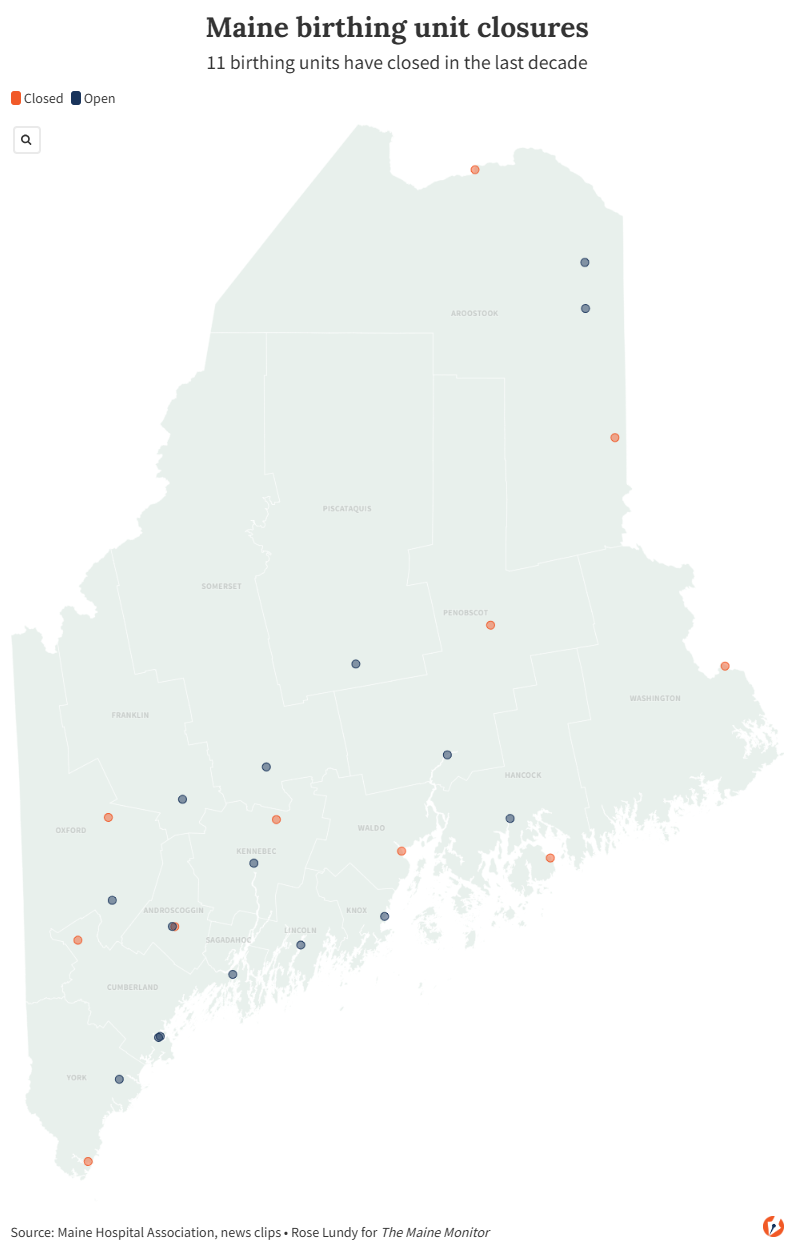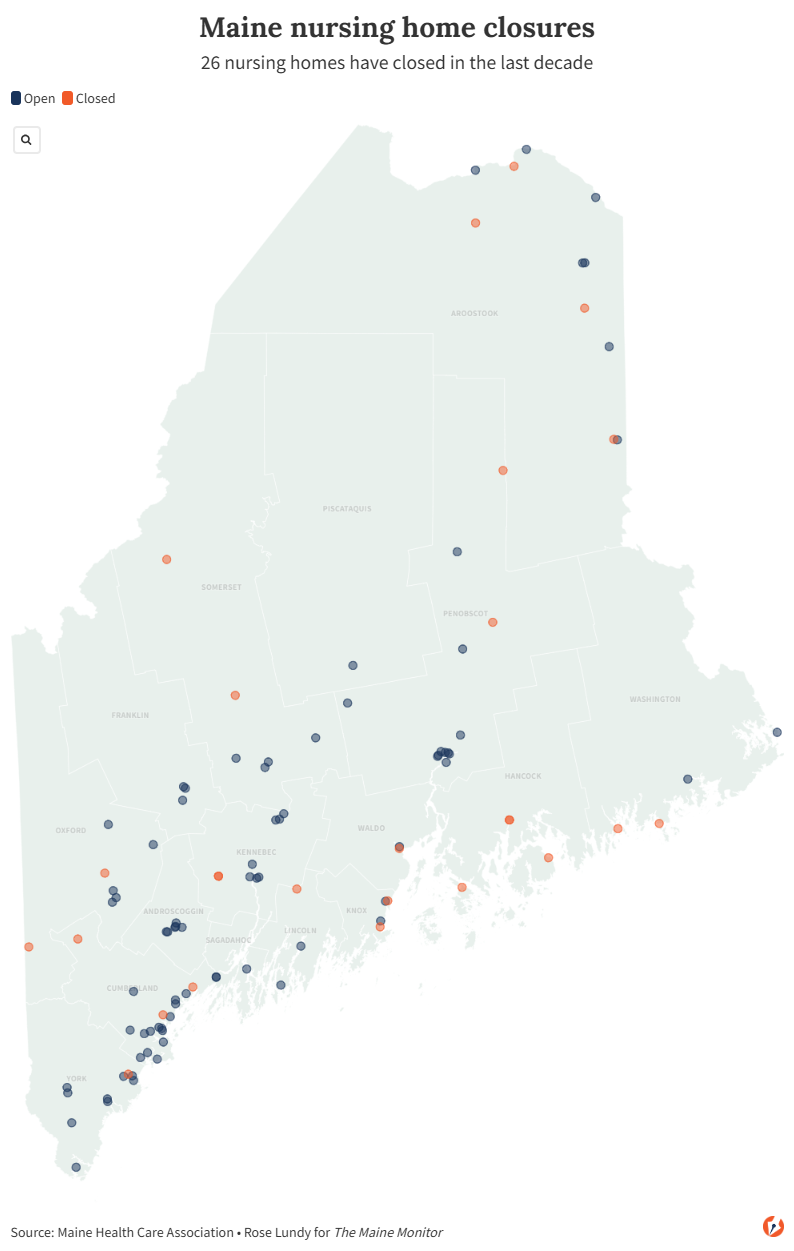|
|
|
|
Mount Desert Island Hospital announced the closure of its birthing unit in July, citing sharply declining birth rates. The Maine State Nurses
Association called it an “abject failure.” Photo by Kate Cough.
|
|
|
See where all of Maine’s delivery wards and nursing homes have closed in the last decade
Whether you are coming into the world or preparing to leave it, one thing is the same: It is becoming harder to find care in many parts of Maine. Over the last decade, two in five hospital birthing units have closed and one in four nursing homes have closed, forcing people to travel greater distances to give birth or find a place for end-of-life care.
To better understand which parts of the state are hit hardest by these closures, I created maps of birthing units and nursing homes that are currently operating, and those that have closed since 2015. I found that Aroostook lost half of its maternity wards; Washington and Waldo counties saw their only birthing units close; and there are now no hospital labor and delivery services in northern Penobscot.
Meanwhile two of four nursing homes in Washington County have closed; all of the nursing homes in Hancock County have shuttered; and there are now no nursing homes left in northern Somerset County.
Birthing units
Eleven birthing units in Maine have closed in the last decade, four of which closed in the last year. The closures leave 16 hospitals with delivery wards remaining across the state.
Mainers whose closest hospital doesn’t have a birthing unit have to instead drive an average of 45 minutes to the nearest birthing hospital, according to analysis by the Center for Healthcare Quality and Payment Reform. This is the longest drive time in New England.
|

|
View the interactive version of this map by clicking here
|
After Mount Desert Island Hospital announced the closure of its birthing unit in July, the Maine State Nurses Association called it an “abject failure.” The hospital cited sharply declining birth rates. The hospital delivered 32 babies last year, a nearly 46 percent decline from the previous year. A decade ago, the hospital averaged about 100 births annually.
Hospital administrators have also cited the difficulty of recruiting OB-GYNs to rural areas. Maine’s singular obstetric residency program is located in Portland at Maine Medical Center.
Changes to Medicaid requirements, which the state has estimated could result in 31,000 Mainers losing their coverage, could have additional impact. Nearly half of all births at hospitals across the state were covered by MaineCare, the state’s version of Medicaid, according to a three-year average from 2021 to 2023 by the Maine Hospital Association.
The state has been considering some potential solutions, including expanding opportunities for OB-GYNs to train and practice in rural areas, and cross-training staff who are already in rural hospitals in obstetrics.
Nursing homes
Over the last decade, 26 nursing homes have closed, leaving 78 operating across the state. Maine, which has the oldest population in the country, had the highest rate of nursing home closures in New England over the last 15 years, according to the Federal Reserve Bank of Boston. And closures across New England outpaced the rest of the country.
One of the biggest challenges for nursing homes is finding and keeping staff. Staffing was a problem years before the COVID-19 pandemic, but the pandemic made it even harder to keep people. The state’s long-term care facilities lost 10 to 15 percent of their workforce during that time.
|

|
View the interactive version of this map by clicking here
|
Staff turnover and shortages create extra costs for nursing homes because they bring in temporary, contracted workers — who earn bigger salaries — to fill shortages. Contracted hours for certified nursing assistants in nursing homes across Maine nearly doubled between 2017 and 2020.
A nursing home’s increasing reliance on work performed by contracted CNAs can be a warning sign. A 2021 Maine Monitor investigation with the Investigative Reporting Workshop detailed which nursing homes saw the largest increases in contract work between 2017 and 2020. One month after the story, five nursing homes closed. Four of them had recorded among the highest increases in work done by
contracted CNAs.
The nursing home industry has said low MaineCare reimbursement rates historically have not kept up with the cost of care, making it difficult for them to stay afloat. Earlier this year, the Maine Department of Health and Human Services updated its MaineCare reimbursement system, which is intended to, among other things, reduce reliance on temporary staff. However, it is too soon to tell whether the new system will be
enough to keep nursing homes open.
Phil Cyr, who operated nursing homes in Aroostook County for nearly 50 years, said low reimbursement was a large part of the reason why he left the industry earlier this year after closing one facility in Presque Isle and selling another in Caribou. Cyr told The Monitor that it was impossible to stay in the business due to increasing regulations, low reimbursement rates and staffing shortages. The Presque
Isle facility lost an estimated $250,000 in just three months because Cyr said he couldn’t find staff and had to operate at 60 percent capacity.
There are many nursing homes still on the edge. Maine Veterans’ Homes, a nonprofit health care provider offering residential care for veterans and their spouses, earlier this year asked lawmakers to approve more than $4 million in funding to prevent them from becoming insolvent within two years.
Nursing home residents aren’t the only people affected when the homes close. When a nursing home closed in Coopers Mills in 2021, neighbors said they worried about the loss of jobs and volunteer opportunities, which gave them a sense of connection. Frank Slason, an 86-year-old whose wife lived in the nursing home, told The Monitor she had to move to another home 30 miles away, making it impossible for him to
continue visiting her every day.
If you’re trying to figure out where to transition an older loved one into a nursing home or assisted living facility, check out my guide to researching these facilities using public databases.
|
|
|
|
|
|
|
|
|
Nearly half of American physicians were employed by or affiliated with hospital systems last year — up from less than 30 percent in 2012 — according to a recent study by the U.S. Government Accountability Office.
Private equity made up about 6.5 percent of ownership of or investment in physician practices, a “small but growing share,” according to the report.
Consolidation of physicians with hospital systems can lead to higher costs for patients due to services happening in more expensive hospital settings, according to the report.
|
|
|
|
|
While The Maine Monitor does not place its content behind paywalls, some newsrooms we link to in this newsletter may.
|
Maine public health officials say federal warning against Tylenol use in pregnancy lacks evidence | Maine Public
Maine public water supply complies with law, but is it safe? | Portland Press Herald
How RFK Jr. is revealing tension between Susan Collins and these top Maine politicians | Bangor Daily News
Babies who can’t breathe when they’re born are at higher risk in rural hospitals. A Portland health care provider is working to change that. | Spectrum News Maine
Advocates warn Mainers will see health premium hikes unless Congress extends subsidies | Maine Public
MaineHealth launches membership-based primary care model | Portland Press Herald
Susan Collins questions former CDC officials in hearing aimed at 'radical transparency' | Maine Public
Maine and 6 other states announce health partnership to push back on RFK Jr. | Bangor Daily News
How MaineCare has grown — and become a budget buster in the process | Portland Press Herald
Study: Maine's largest public water supplies are contaminated with hexavalent chromium | Maine Public
|
|
|
Get in touch: If you have any story suggestions, feedback or corrections, please never hesitate to reach out to me. I love
hearing from readers: rose@themainemonitor.org.
The Maine Monitor is a publication of the Maine Center for Public Interest Reporting, an independent and nonpartisan nonprofit news organization that produces investigative journalism. We believe news is a public good and keep our news free to access. We have no paywall and do not charge for our newsletters. If you value the reporting we do for Maine, please consider making a donation! We cannot do this reporting without your support.
|
|
|
|
|
|
|
|
|
|
|